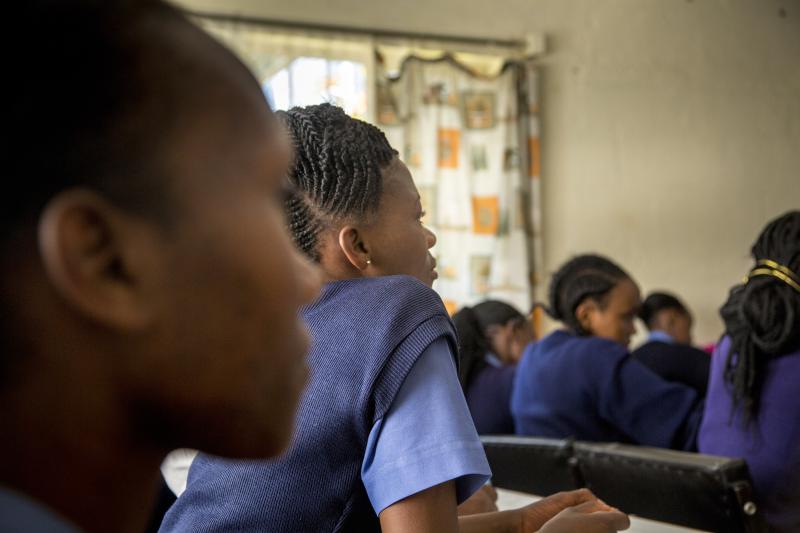Where We Work
See our interactive map


Afya Elimu Fund loan recipients are able to complete their health professional education thanks to the low-interest loan program. Photo by Georgina Goodwin for IntraHealth International.
The Afya Elimu Fund is the first of its kind.
In Kenya, there’s no shortage of young people who want to serve their communities by becoming health workers. But for the 36% of Kenyans who live below the poverty line, higher education is unreachable.
That’s why IntraHealth International’s Janet Muriuki is thrilled about the Afya Elimu Fund for promising allied health students.
The fund enables students from low-income backgrounds who wish to pursue careers as health professionals to complete their education without interruption by providing them with a low-interest loan to cover their tuition fees.
This has an impact on the beneficiaries and their families, but also on health care delivery in the country. That excites me.
It started off as a scholarship program, but with time, we questioned its sustainability. In 2013, after discussions with USAID, the Ministry of Health, and the Ministry of Education’s Higher Education Loans Board, we brought in the private sector and revolutionized the approach from scholarships to loans.
We're now looking at a fund worth 2.4 billion Kenya shillings, or US$241 million, which has supported 33,251 students. To date, 54 million Kenya shillings (about US$540,000) has been paid back. The fund is on the road toward revolving.
As of September 2019, we’ve graduated 8,500 students. But we're not satisfied when they’ve gotten an education—we’re aiming for gainful employment so they can pay back their loans, have an impact as health workers, and provide for their families as they provide health services to Kenyans.
While students are in school, we raise awareness about the loan and show them how to look for employment. We post job opportunities that we receive from the county and national governments. Twice a year, we hold job forums with employers to showcase some of the students and graduates. And we use iHRIS to keep track of graduated students. That way, a county knows where to find graduates to hire as health workers.
We need more leaders who have a systems-thinking approach.
We must respond to the call for universal health coverage and pay more attention to noncommunicable diseases alongside HIV and reproductive, maternal, neonatal, child, and adolescent health services.
We need more domestic financing to improve services and decrease our reliance on donor funding, especially now with USAID’s Journey to Self-Reliance. USAID is just one donor, but others are joining the push and asking for countries to put more on the table for the health sector.
We need to couple accountability with transparency to curb corruption, ensure effective and efficient use of human capital, and make sure resources are targeted and well-utilized.
Passion and commitment are critical for health workers on the front lines and among leaders throughout the health sector, because commitment and support bring about transformation.
When I look at what we’re doing through IntraHealth’s programs, we are on course.
In Kenya, we’ve put sustainability measures in place by training county human resources for health officers on mentorship. We’ve even trained some of them as trainers of trainers for human resource management, leadership and management, and iHRIS. We have more funding from the government than from donors for Afya Elimu.
Some county governments are already allocating their own resources to support monthly human resources for health technical working group meetings as well as quarterly intercounty human resources for health stakeholders’ coordination forums.
And we have started transitioning the Afya Elimu Fund to the Higher Education Loans Board by improving systems and processes, which is in line with the Journey to Self-Reliance—USAID’s vision of transferring ownership to country-based institutions and funders.
To date, the ministry of education’s contribution to Afya Elimu makes up 70% of the fund’s assets. This demonstrates government ownership and fund sustainability. It’s the first of its kind for these allied health students, who become critical health workers at the community level and in health facilities. Afya Elimu will have a life of its own beyond our project!
IntraHealth has been asked to help develop three of Kenya’s national human resources for health strategic plans. First in 2010, with the creation of the first documented strategic plan for HRH, then the second in 2014, and again last year. This is unusual—normally, different organizations would be called upon at different times. But we’ve consistently had the right technical expertise and we’ve given the ministry and counties confidence that we are the best people to help develop these documents.
We’ve built our niche as the go-to organization in matters of human resources for health.
The Human Resources for Health (HRH) Kenya program is a five-year, USAID-funded project that strengthens health professional training programs and health workforce management systems throughout Kenya to help the country improve the health of its citizens.
This piece is part of IntraHealth's celebration of 40 years of commitment to health workers. Follow along: #TheFutureOf #IntraHealth40 #HealthWorkersCount
Get the latest updates from the blog and eNews




